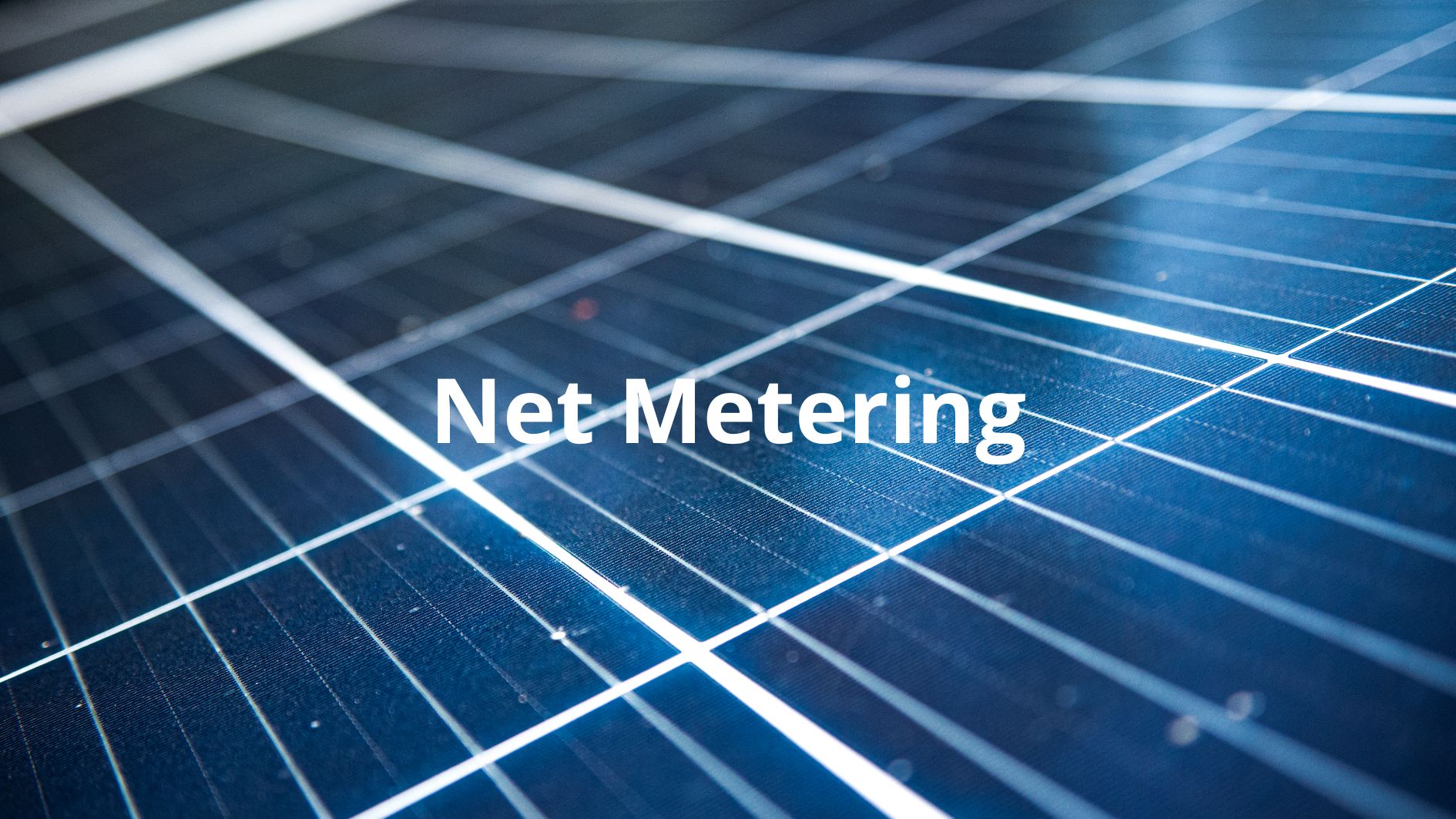Image source: Canva.com
Net metering stands as a crucial solar incentive, operating on a straightforward principle: you accumulate credits by supplying excess solar electricity to the grid. These credits offset the energy you draw from your utility when solar production is insufficient, effectively reducing or potentially eliminating your electric bills with solar panels.
In 2023, four states, in addition to California, made notable revisions to their net metering policies, leading to a reduction in the compensation rates for solar energy producers. These changes reflect a broader trend toward altering net metering frameworks to address various economic and regulatory concerns. Moreover, this year is expected to see further substantial modifications, with an additional five states preparing to introduce significant changes to their net metering policies. These evolving policies could have a considerable impact on the solar energy industry and its stakeholders, influencing both the financial benefits and the overall landscape of solar energy adoption across the country.

Net Metering: Your Guide to Solar Energy Billing
What Factors Are Driving States to Revisit Net Metering Policies?
States are revisiting net metering policies for several reasons:

Financial Impact on Utilities
As more homeowners adopt solar power, utilities lose revenue from reduced electricity sales. To compensate, utilities may need to raise rates, which can affect all customers, particularly those who do not have solar panels.

Grid Stability and Maintenance Costs
Utilities argue that maintaining the grid and ensuring stable electricity supply requires significant investment. Net metering policies, which credit solar customers at retail rates, can reduce the funds available for these essential services.

Fairness and Equity Concerns
There is concern that net metering benefits wealthier households who can afford solar installations, while low-income customers bear the brunt of increased utility rates. Revising net metering policies aims to distribute costs more equitably across all customers.

Encouraging Battery Storage
By reducing net metering benefits, states and utilities aim to incentivize the adoption of battery storage systems. These systems can store excess solar energy for later use, reducing the strain on the grid and enhancing overall energy resilience.

Adapting to Changing Energy Markets
The energy landscape is evolving, with increasing renewable energy integration and changing consumption patterns. States are revisiting net metering policies to ensure they align with current and future energy market dynamics.

Policy and Regulatory Pressure
Utilities and other stakeholders often lobby for changes to net metering policies to protect their financial interests and ensure long-term sustainability of the grid.
By revisiting net metering policies, states aim to balance the growth of solar energy with the financial health of utilities, grid stability, and equitable distribution of costs and benefits among all customers.
Which States Implemented Major Net Metering Changes in 2023?
In 2023, four states approved significant amendments to their net metering or net billing policies, reducing compensation for homeowners who install solar panels.
Arkansas

In Arkansas, homeowners have until September 30, 2024, to install solar panels and secure net metering for 20 years. Legislation enacted last year mandates a transition to net billing. Waiting to go solar means receiving compensation at the lower avoided cost rate instead of the retail rate, potentially missing out on substantial savings.
Hawaii

Hawaii switched from net metering to net billing in 2015. Homeowners still install solar panels, but many now pair them with batteries to reduce grid dependence. In 2022, Hawaiian Electric faced an electricity shortage after closing a coal-fired power plant. To encourage solar customers to supply electricity to the grid, the utility created the Battery Bonus Program.
This program offered a generous upfront bonus and additional payments for electricity sent to the grid. The program’s success led to a 96% battery attachment rate in 2022, but it stopped accepting new applicants in December 2023. The successor program, Bring Your Own Device (BYOD), started in March 2024, but it is more complicated, offers lower compensation, and requires a new time-of-use (TOU) electricity rate plan, which may result in a net loss for participants.
Idaho

In December 2023, the Idaho Public Utilities Commission approved a shift from net metering to net billing for Idaho Power, which the Sierra Club estimates reduces solar export compensation by about 32%. The new rates took effect on January 1, 2024.
Homeowners who installed or purchased their systems by December 20, 2019, are grandfathered into net metering until December 20, 2045. Others are already receiving lower compensation and might consider adding a battery.
North Carolina

The North Carolina Utilities Commission approved Duke Energy’s switch from net metering to a TOU export rate in March 2023. The new compensation rates include a grid access fee and reduce electric bill savings by about 30-40% for most solar homeowners. Installers who applied for interconnection before October 2023 are grandfathered into net metering until 2027.
After 2027, they will transition to a modified net metering rate called the Bridge Rate for 15 years after the interconnection date. The Bridge Rate includes a minimum bill requirement and some additional charges but does not require a grid access fee or TOU rates, resulting in higher savings than the TOU export rate.
For those in North Carolina who have not yet gone solar, there is still an opportunity. By investing in a system before 2027, you can opt for the Bridge Rate and be grandfathered in for 15 years. However, this is subject to annual caps, so it’s advisable to confirm eligibility and consider going solar early in the year.

What Are the Financial Benefits of Solar under NEM 3.0?
What Comes After Net Metering?
It’s been almost a year since California implemented its net billing tariff. While each state has its own unique circumstances, California serves as a valuable case study for understanding the impacts of transitioning away from net metering on the solar industry. Here’s what we’ve observed in California so far, and what industry experts predict for 2024:
Fewer Solar Installations and Less Confidence in the Industry
California’s solar growth has already slowed and is expected to decline further due to net billing. According to Wood Mackenzie, a global research firm, California installations are predicted to decrease by 38% in 2024. ROTH Capital Partners, LLC, an investment bank, forecasts a 50% market contraction in the same year.
Surveys of California installers revealed that they anticipate a 23% decline in sales for 2024 compared to 2023. They also expected a 15% decrease in 2023 sales year-over-year, despite a significant surge in installations early in the year before net billing was implemented in April 2023. Additionally, 65% of respondents expressed reduced confidence in the solar industry compared to the previous year.
Increased Battery Storage
In the first half of 2023, California had the lowest interest in battery storage among states. However, following the switch to net billing, it rose to the fifth most interested state.
California installers are ready to meet this growing demand for storage. Half of the surveyed installers indicated they would now only install solar panel systems paired with batteries in response to the new net billing tariff.
Impact on Employment
A more extensive survey by the California Solar and Storage Association (CALSSA) presents a different perspective. It revealed that around 17,000 solar jobs, or about 22% of the workforce, were lost in 2023 as a result of changes to net metering policies. Additionally, 59% of installers expect further layoffs in the future. These findings underscore the substantial challenges and adjustments the solar industry faces as states transition away from net metering.
States to Watch in 2024
Despite significant setbacks for the California solar industry, several states are already considering similar net metering changes in 2024. If you live in one of the following states, it might be wise to go solar sooner rather than later before any new policies are approved.
Arizona

Arizona switched from net metering to net billing in 2016, significantly reducing the payback amounts to solar owners who send power back to the grid. In October 2023, the Arizona Corporation Commission began exploring whether to further reduce compensation rates by over 10%. No decisions have been made yet.
Illinois

Illinois is set to transition away from net metering in 2025. While the new compensation rate plan is not yet finalized, the expected savings are likely to decrease. If you register for net metering before January 1, 2025, you’ll be grandfathered in for your system’s lifetime. If you’re in Illinois and considering solar, now is the time to act.
Oregon

Idaho Power, which provides electricity to customers in eastern Oregon, is proposing to transition Oregon from net metering to net billing, similar to changes implemented in Idaho. Although Oregon previously rejected these changes, Idaho Power is expected to continue pushing for them throughout 2024.
West Virginia

In West Virginia, Monongahela Power and Potomac Edison have proposed transitioning from net metering to net billing for homeowners connecting solar panel systems on or after March 27, 2024. Regulators are currently reviewing the proposal, which would halve the compensation for sending solar electricity to the grid.
The Public Service Commission of West Virginia has recommended a 32% reduction instead of the proposed 49%, suggesting some changes are likely.
Wisconsin

Madison Gas & Electric and Wisconsin Power & Light both filed proposals in 2023 to switch from net metering to net billing. Although Wisconsin regulators rejected the changes, the Wisconsin Public Service Commission has decided to investigate the value of net metering. This investigation could lead to new proposals to reduce net metering in the state this year.
If you live in one of these states and are considering solar, it’s advisable to act soon before new policies potentially reduce the benefits of going solar.
How to Secure the Best Solar Savings
These states are under our closest scrutiny, but there are additional states where net metering could soon be phased out. Installing solar panels promptly offers the best opportunity to secure maximum long-term savings on your investment. Currently, most states have grandfathered existing solar customers into net metering for an extended period. This means that even if your state implements significant changes to net metering compensation rates, you may be shielded from these impacts if you already have solar. We’re here to assist with that process. Join SolarWiki to compare multiple solar quotes and discover your potential savings.
Disclaimer: The information presented here is intended to provide a general overview of net metering policies and their potential benefits for homeowners with solar installations. However, this information should not be considered as official financial, legal, or technical advice. Net metering policies, utility rates, and incentive programs can vary significantly by location and are subject to change over time.





